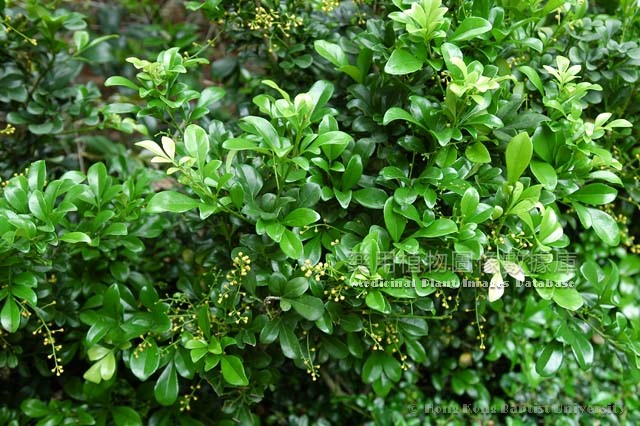|
|
|
Aglaia odorata Lour.

|
English Name |
Mock Lime, Chulan Aglaia, Aglaia Tree, Maizailan, Orchid Tree |
|
Latin name |
Aglaia odorata Lour. |
|
Family & Genus |
Meliaceae, Aglaia |
|
Description |
Evergreen shrubs or small trees, 4-7m tall. Multi-branched, usually young part with stellate ferruginous scales. Odd-pinnate compound leaves alternate, 5-12cm long, rachis narrow-winged; leaflets 3-5, opposite, obovoid to oblong, 2-7cm long, 1-3.5cm wide, apex blunt, base cuneate, margin entire, glabrous. Panicles axillary; flowers polygamous, dioecious; calyx 5 lobes , lobes round; petals 5, yellow, oblong to nearly round, extremely fragrant; stamens 5, filaments connated to tube, tube slightly shorter than petals, apex margin entire; ovary ovate, dense yellow coarse hairs, style extremely short, stigma with scattered star-shaped scales. Berry ovate or nearly spherical, diameter ca. 1cm, scattered star-shaped hairs when young, then become glabrous. Seeds with succulent aril. Flowering: June to November. |
|
Distribution |
Growing in forests with wet and fertile soil or sandy loam. Also cultivated. Distributed in Fujian, Taiwan, Guangdong, Guangxi, Sichuan, Yunnan and etc. |
|
Part Used |
Medical part: branches and flowers. Chinese name: branches and leaves: Mizilan. Flower: Mizilanhua. |
|
Harvest & Processing |
Branches and leaves: harvested throughout the year. Used fresh or sun-dried. Flowers: gently beat down by bamboo pole the buds, removed impurities and collected for drying in the shade. |
|
Chemistry |
Branches and leaves contain triterpenoids: aglaiol, aglaiondiol, aglaitrioland aglaione; alkaloids: odorine and odorinol, etc. Flowers contain volatile oil consisting of a-humulene, β-caryophyllene, β-cubebene and β-gurjunene, etc. |
|
Properties & Actions |
Branches and leaves: pungent, little warm. Flower: pungent, sweet, neutral.Branches and leaves: dispelling wind and dampness, removing stasis and swelling. Flowers: promoting circulation and alleviating middle energizer, ventilating lung to relieve cough. |
|
Indications & Usage |
Branches and leaves: pain in rheumatic joints, injuries from falls, superficial infections, toxic swelling. Flower: distress of chest and diaphragm, onset of achalasia cardiae, common cold and cough.Branches and leaves: oral administration: decocting, 6-12g; application: appropriate amount, or applied in smashed form or prepared ointment for external application. Flowers: oral administration: decocting, 3-9g; or infused with boiled water. |
|
Examples |
1. Injuries from falls and fracture, ulcerative carbuncle: (mock lime) branch and leaves 9-12g, decoct and swallow. Mash the fresh leaves into paste, prepare with water, pached hot and smear onto lesions.
3. Distension of chest and diaphragm: aglaia odorata, wrinkled gianthyssop, loquat leaves, dendrobium, bamboo shavings, red tangerine peel, 9g each. Decoct in water and swallow. |
|
Permanent URL:https://sys01.lib.hkbu.edu.hk/cmed/mpid/detail.php?herb_id=D00922 |
|
|
|

